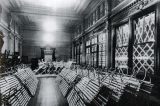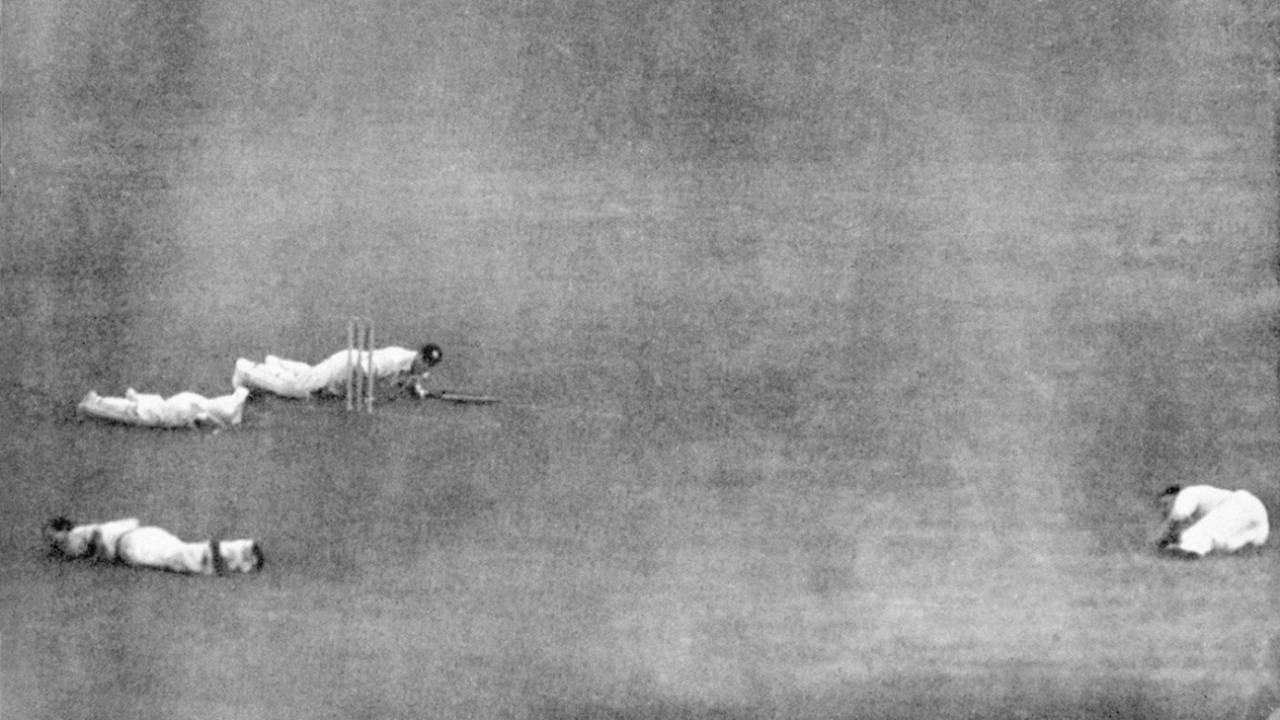Lord's under attack
Martin Williamson looks back at how Lord's survived the Second World War
Martin Williamson
06-May-2006
Army's Jack Robertson (batting), RAF's Andy Wilson (wicketkeeper), Bill Edrich (bottom left) and Austin Matthews (right) take cover as a V1 flying bomb falls near Lord's • Getty Images
In the Great War (1914-18) little cricket was played, certainly until the latter stages of the conflict, as it was considered unpatriotic to be taking part in games while troops were being slaughtered so close to home. Gradually that attitude changed, and by 1917 matches were being held at major grounds, usually for charity.
At the outbreak of the Second World War, there was no similar move to put everything on hold. Indeed, over the winter of 1939-40 several counties considered the possibility of staging a limited County Championship during the following summer. The absence of most players on active service scuppered that, but games continued with servicemen on leave and based at home - and it should be remembered that Britain did not return to mainland Europe until 1944, so the number of UK-based players was high.
Large crowds attended matches, nowhere more so than at Lord's, where Pelham Warner, the acting secretary, maintained an attractive and busy schedule throughout. What was remarkable was that there were only two serious interruptions to games, even though the Luftwaffe staged bombing raids throughout the war.
The first interruption came in July 1942 when Andy Ducat, who had played both cricket and football for England, collapsed and died at the wicket. It was a tragic but somehow fitting way to go.
The second provided probably the most enduring cricket-related photograph of the conflict. By 1944 , the Germans had unleashed the V1 flying bomb - the doodlebug - and in July and August of that year over 8000 were launched, with 2600 reaching their targets, with nine in ten hitting London. The death toll was thought to be around 2000 in that period. Flats near Lord's and the synagogue opposite the Grace Gates were hit by flying bombs.
On Saturday, July 29 the Army played the RAF at Lord's in front of 3100 spectators, many attracted by the return from abroad of England's pre-war captain Wally Hammond, who had conveniently been billeted in nearby Regent's Park following his medical discharge from the army.
|
|

|
Wyatt had thrown himself to the ground, midway through his run-up and still clutching the ball, as had all the other players. The spectators took what cover they could where they were - "the spectators were to be seen in curious postures in the pavilion and round the ground," wrote Warner in his history of Lord's.
Fortunately, the flying bomb fell about 200 yards short of the ground and landed in Albert Road, north of Regent's Park.
The players calmly rose and the spectators resumed their places. Without returning to the start of his mark, Wyatt continued his run-up and bowled to Robertson who hammered the ball into the grandstand for six, to the delight of the crowd.
Less than a fortnight later, Lord's was again in the firing line as another V1 fell close to the ground during a match between a Lord's XI and a Public School's XI, showering the outfield with shrapnel and debris. Forttunately, none of the players or the small crowd were hurt, and play resumed after a short delay. In between these two matches, Hammond had hit 105 for England against Australia in a one-day (as opposed to limited-overs) match in front of 16,000 spectators.
|
|

|
Perhaps the most high-profile damage to Lord's came not from the Luftwaffe but from a barrage balloon - a blimp suspended a few hundred feet from the ground aimed at prevented low-level fighter attacks. The steel cable holding one of these broke loose in a wind and wrapped itself round Father Time, depositing it among the seating at the front of the Grandstand.
At least Lord's remained a cricket ground. London's other major venue, The Oval, was designated as a holding area for prisoners of war and the grass ripped up and barbed-wire compounds erected. No POWs were ever held there, but when it was handed back to Surrey CCC in 1945, the authorities there faced a massive job in getting it fit to host cricket again.
Is there an incident from the past you would like to know more about? E-mail us with your comments and suggestions.
Bibliography
The Cricketer Various
Lord's 1787-1945 Sir Pelham Warner (Methuen 1945)
The Lost Seasons Eric Midwinter (Methuen 1987) Various
The Cricketer Various
Lord's 1787-1945 Sir Pelham Warner (Methuen 1945)
The Lost Seasons Eric Midwinter (Methuen 1987) Various
Martin Williamson is managing editor of Cricinfo
